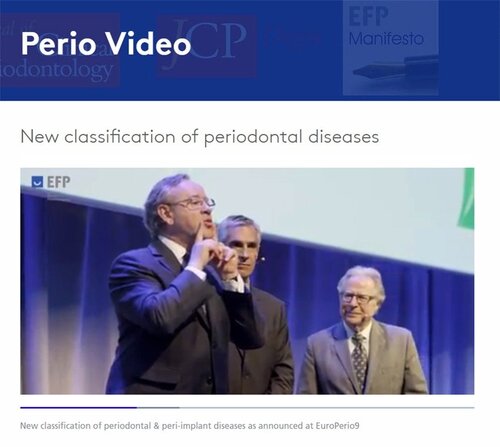![]()
6 August 2018
EFP releases video on new classification of periodontal and peri-implant diseases
Categories:New Classification, Science

The EFP has released a video about the new classification of periodontal and peri-implant diseases that is set to have a global impact on the practice of periodontology and implant dentistry.
The new classification, based on the latest evidence-based science, was unveiled at EuroPerio9 in Amsterdam in June.
It is the fruit of the World Workshop on the Classification of Periodontal and Peri-Implant Diseases and Conditions, held in Chicago in November 2017, organised by the American Academy of Periodontology (AAP) and the EFP.
The video features comments from the four EFP co-chairs of the World Workshop’s working groups, and from Maurizio Tonetti, editor of the Journal of Clinical Periodontology in which the proceedings of the workshop have been published in an open-access supplement.
EFP secretary general Iain Chapple, who chaired working group 1 (Periodontal health and gingival diseases and conditions), says that the 2017 World Workshop was “really critical” because “it is really important that we have an international language through which we can talk about and explore through research periodontal diseases.”
He adds that one of the key tasks of his working group was to define what is meant by periodontal health because “unless you define health, you cannot define disease.”
"A major step forward"
Mariano Sanz, chair of the EFP workshop committee and co-chair of working group 2 (Periodontitis), describes how the World Workshop gathered together more than 130 experts, who reviewed the evidence in depth to propose a new classification that covers gingival and periodontal health, gingivitis, periodontitis, all the conditions affecting the periodontium, and peri-implantitis.
He explains the “completely new view” on how to identify and treat periodontitis patients, and how to propose personalised therapies according to the stages and grades of disease.
Søren Jepsen, the scientific chair of EuroPerio9 who chaired working group 3 (Periodontal manifestations of systemic diseases and developmental and acquired conditions), says one of the main outcomes of his group was developing a new classification of mucogingival defects that takes into account both recessions and the condition of the root surface exposed by recession.
Tord Berglundh, co-chair of working group 4 (peri-implant diseases and conditions), says that the consensus workshop was “a major step forward not only for periodontology but also for periodontology as a whole.” He adds that the information published and available to clinicians “will be a tool for facilitating communications between patients and clinicians.”
Prof Tonetti says that the new classification is important for three reasons: “One, it is needed; two, it’s transformative; three, it is global.” He adds that “this is the type of content that empowers every one of us to be a much better practitioner through reading, studying, and implementing these findings in practice.”
The video also features some reactions from EuroPerio9 delegates to the presentation of the new classification. Comments include “it seems like a very useful system, with the grading and staging” and “it will help us with making clinical decisions and treatment planning.”
The latest issue of the EFP magazine Perio Insight is dedicated to the new classification and features articles by professors Chapple, Sanz, Jepsen, and Berglundh. It can be downloaded in pdf format from the EFP website.
At a meeting during EuroPerio9, the EFP and the AAP agreed to set up a joint standing committee and steering group to oversee moves to explain the new classification and train oral-healthcare teams on how to implement it in daily clinical practice.




